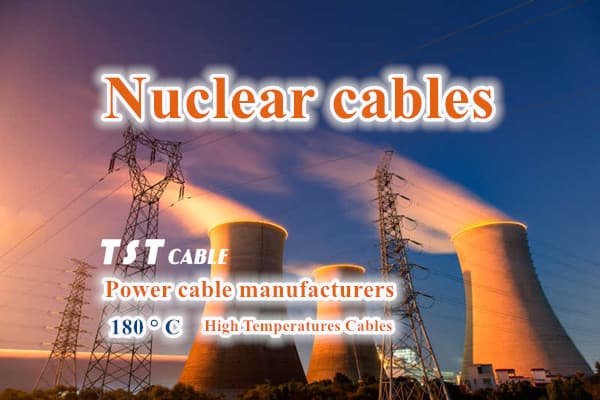In the nuclear power plant environment, the selection of cables is crucial because they need to maintain stable performance under extreme conditions, including withstanding high temperature, chemical corrosion and the influence of nuclear radiation. PEEK (polyetheretherketone) cable and PI (polyimide) cable are both special cables made of high-performance materials, and have their own application scenarios in nuclear power plants. TST CABLES will take you to learn about the characteristics and applications of these two special cables.

1. Material characteristics and core application scenarios
PEEK cable (polyetheretherketone)
Characteristics: It has high temperature resistance (long-term use temperature 250℃), chemical corrosion resistance, radiation resistance, low smoke and halogen-free, flame retardant and other characteristics, and still maintains high mechanical strength and electrical insulation performance at high temperatures.
Nuclear power plant application:
Nuclear island drive mechanism winding coil: can be used for a long time in a high radiation environment, such as power transmission of the drive mechanism inside the nuclear island.
Electrical penetration: used to connect equipment inside and outside the nuclear island to ensure sealing and electrical performance throughout the life cycle.
Containment dome: It needs to withstand high-temperature and high-pressure steam shock, and PEEK has been verified to have stability through thermal aging tests.
Application: PEEK is widely used in nuclear power plants due to its excellent mechanical strength, chemical resistance and good electrical insulation properties. It is particularly suitable for connecting wires that need to be exposed to high temperature environments for a long time, such as sensor lines, control systems, etc.
Nuclear radiation level: PEEK material has good resistance to gamma rays and other forms of ionizing radiation. Studies have shown that PEEK can maintain its physical and mechanical properties at cumulative doses of up to 10^6 Gy (Gray), which makes it very suitable for use in nuclear power plants, especially in applications that may be exposed to higher levels of radiation.
PI cable (polyimide)
Features: wider temperature resistance range (-269℃~400℃), better creep resistance than PEEK (especially above 150℃), low dielectric loss, wear resistance and cleanliness (extremely low exhaust and metal impurities).
Nuclear power plant applications:
High-temperature instrument cable: suitable for signal transmission in high-temperature areas of nuclear power plants, such as reactor peripheral high-temperature monitoring systems.
Radiation-resistant measurement cable: PI can be used as an insulating layer in scenarios where extreme temperature stability and radiation resistance are required.
Application: PI cable is known for its excellent heat resistance, aging resistance and excellent electrical insulation properties, and is suitable for occasions requiring extremely high temperature stability. In nuclear power plants, PI cables are often used for power transmission and signal transmission in high-temperature areas, such as the control lines of reactor cooling systems.
Nuclear radiation level: Although PI material also has a certain radiation resistance, its performance under extremely high radiation doses is slightly inferior to PEEK. However, for the actual operating conditions of most nuclear power plants, PI cables can still provide sufficient protection and can still maintain their functions under cumulative radiation doses of millions of Gy.
2. Comparison of nuclear radiation levels and environmental resistance between PEEK and PI cables
Radiation tolerance of PEEK cables
PEEK materials have passed the LOCA (loss of coolant accident) test and can withstand high-dose radiation (such as below 375kGy), which is suitable for the harsh environment inside and outside the containment of nuclear power plants.
Safety level: PEEK cables usually meet the K1 requirements of nuclear-grade cables (the most stringent level) and need to remain functional after an accident.
Radiation tolerance of PI cables
PI materials show “excellent radiation resistance” to gamma rays, but the specific tolerance dose is not clearly marked. Its application is more inclined to K2/K3 scenarios (such as the periphery of nuclear power plants or non-accident environments), focusing on high temperature stability rather than extreme radiation protection.
- Comprehensive comparison of PEEK cables and PI cables
| Dimensions | PEEK cable | PI cable |
| Temperature range | Long-term 250℃, short-term 260℃ | Long-term 400℃, short-term higher |
| Nuclear radiation level | Class K1 (high-dose radiation, below 375kGy) | K2/K3 category (focusing on high temperature stability) |
| Core advantages | Radiation-resistant, LOCA-resistant, low-smoke and halogen-free | Ultra-wide temperature range, creep resistance, cleanliness |
| Typical applications | Electrical penetrations and drive mechanisms inside the nuclear island | High-temperature instrumentation, peripheral monitoring system |
Comparison Summary
Temperature resistance: Both perform well, but in extreme high temperature environments, PI cable is generally considered to be superior because it can work for a long time at temperatures close to 300°C or even higher.
Radiation resistance: PEEK cable may have a slight advantage when facing high-dose radiation, but both can meet the needs of most areas in nuclear power plants.
Comprehensive considerations: Which cable to choose depends on the requirements of the specific application scenario. If the project is mainly concerned with temperature resistance, PI may be a better choice; if comprehensive performance including mechanical strength and radiation resistance is considered, PEEK may be more suitable.
No matter which cable is chosen, it is necessary to determine the best option for a specific application based on detailed engineering analysis and risk assessment. In addition, it is also necessary to pay attention to complying with relevant industry standards and safety regulations. If you are not sure which specification of nuclear power plant cable to choose, you are welcome to email us for consultation and get free samples.
Also available in:
English




